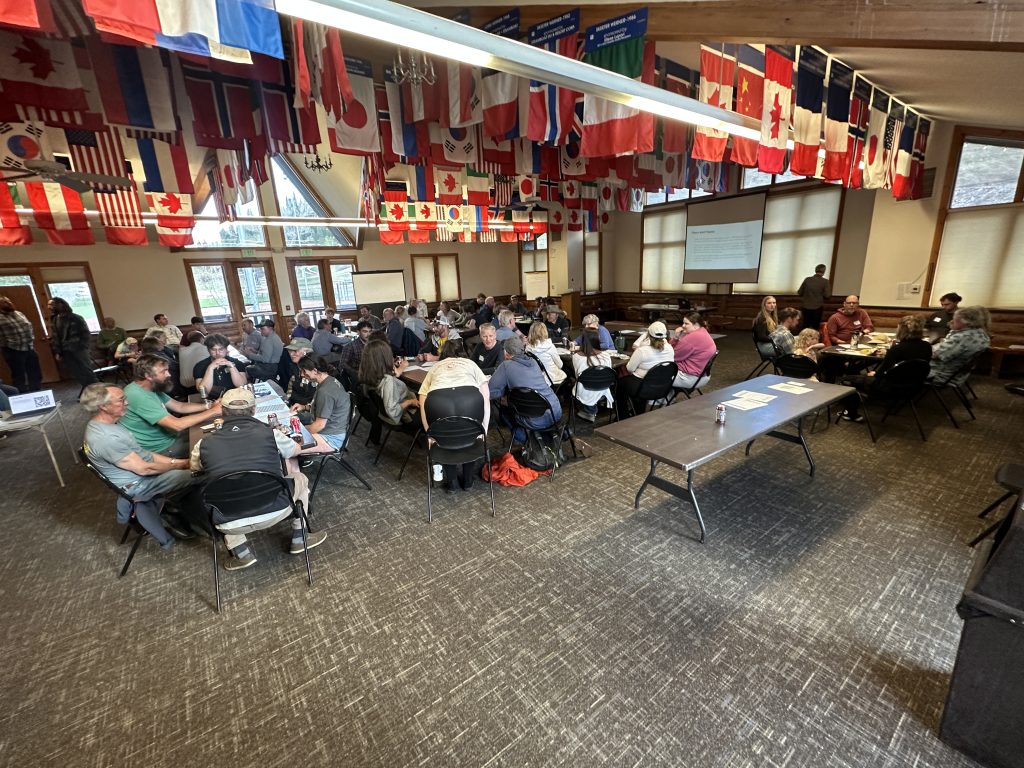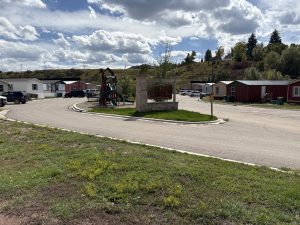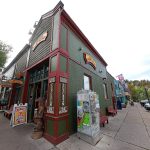Steamboat residents seek common ground at Brown Ranch community workshop

Julia Coccaro/Steamboat Pilot & Today
Steamboat Springs residents gathered Thursday evening for a community workshop on the future of Brown Ranch, marking the kickoff of a new engagement cycle aimed at finding common ground within one of the city’s most pressing and divisive issues:
Affordable housing and growth, and its impact on community character.
The event, attended by over 40 local residents, was facilitated by the Yampa Valley Housing Authority in partnership with the consultant team Community Builders and the community-based nonprofit The Civic Canopy.
In March 2024, Steamboat voters rejected the Brown Ranch annexation proposal required to move the project forward. The defeat paused development and prompted city leaders and housing advocates to seek new ways to engage the public and find consensus on Brown Ranch’s future.
Kale McMonagle, collaboration director for The Civic Canopy, opened the workshop by emphasizing the need for a fresh start.
“The purpose of tonight is going to be to collaborate to identify possible solutions for Brown Ranch,” she said, noting that the process was intentionally open-ended. “We’re at the very beginning of a new community engagement cycle to think through what’s next, including if there’s something next, what that thing that’s next could be, what it could look like and when it could happen.”
McMonagle explained that the engagement would run through August, with multiple workshops and opportunities for input. She outlined a three-tiered process: broad community involvement, a 40-member Deliberation and Stewardship Team selected to represent a cross-section of residents and a project collaboration team bridging the city and the housing authority.
“All of these groups connect with each other,” said McMonagle, describing a feedback loop in which community input would inform the stewardship team and, ultimately, any future proposals.
Participants were introduced to an interactive polling tool designed to surface values, hopes and concerns. Each attendee could agree, disagree or add their own statements, creating a dynamic, real-time snapshot of community values. Within minutes, the number of statements grew from 30 to 56.
“We only actually have one statement here that showed us as very, very divisive,” McMonagle said. “‘Prepare for future disasters with an eye toward crises like wildfires, drought, increased temperatures or deserts.’ This one had the most mix between people who agreed and disagreed.”
In contrast, broad agreement emerged around statements such as “retain our middle class by providing opportunities for families and younger professionals to put down roots,” “take a proactive approach to planning for the future” and “protect our diverse economy that includes but doesn’t solely depend on the ski resort and tourism.”
When the conversation shifted to fears, the anxieties were palpable and often personal.
“I’m worried Steamboat will become so unaffordable it’ll become a hollow, fake town like Aspen,” said Steamboat resident Tyler Kitchin.
The “Aspen effect,” shorthand for the loss of local character and diversity due to soaring housing costs and a prioritization of tourism, was repeatedly mentioned by various participants.
Others worried that Brown Ranch would fail to deliver on its promise of housing for young people and working families.
“We concentrated a lot on the impediment to young people and mainly housing and a fear that Brown Ranch will not satisfy that need,” one participant said of their table’s discussion.
“My biggest fear is that the project will never happen because the cost will continue to escalate and it won’t become feasible,” said another.
The connection between housing and workforce stability was a recurring theme.
“If we don’t solve the affordable housing problem, the composition, the makeup of the people who compose Steamboat Springs is going to change dramatically when we can’t hire teachers to work here, we can’t hire people to work for the not-for-profit organizations that we’re so proud of, or any kind of medium-level professionals,” said one attendee.
“I serve on the board of several organizations that have not been able to hire people because we can’t find housing for them, so they’ve turned down jobs,” they added.
Traffic and infrastructure concerns were also raised, with some questioning whether Brown Ranch could worsen congestion on U.S. Highway 40, while others argued that the real issue was the need to bring existing commuters closer to town.
“I hear traffic a lot. That traffic is already there because most of those people are already living in Hayden and Craig,” said Kitchin. “It’s not to me on the top even 10 concerns of what Brown Ranch might have. Let’s get the people closer to town, into the public transportation system.”
“As a young person in Steamboat I would like to be able to not have to live in a secondary dwelling unit,” expressed a young woman. “I don’t really want to live over someone’s garage. I would like to live somewhere where, if the infrastructure works, it can also be connected to town, and I also want it to be affordable so we can live in a single-family home, if that could exist.”
Local resident Dallas Elmore underscored the need for locals to be willing to integrate those living in affordable housing into the community.
“They’re not less-than because they have to live in affordable housing,” said Elmore. “Those are going to be the folks who are staffing your grocery store, fighting your fires, putting your criminals away and educating your kids. And so they deserve a shot to live here as well.”
Others called for rethinking the narrative around Brown Ranch.
“Can it go from a place for our low-income people to live, to the place that locals live?” a community member identifying himself as Jeremy asked, noting that the narrative “has been really struggling.”
“Can it be the most prestigious place for a local to live…can Brown Ranch sort of be the opposite of how it’s been characterized?”
Some participants questioned whether “affordable housing” was even the right term, suggesting “locals’ housing” might better capture the goal. Others debated the merits of infill versus new development, the balance between density and livability, and whether past failures were due to lack of information or lack of inclusion – particularly for Routt County residents who could not vote on previous Brown Ranch proposals due to living outside of city limits.
“Make Brown Ranch off-the-grid, a model for the nation, something that we can really well plan out,” said resident Dave Miller, who described this as a “win-win” approach. “Low density population, we wouldn’t have the transportation problem and the cost for all the utilities would be less. But then take the money from that and sell the land, have them make payments and have the money go to the transportation corridor.”
At the close of the workshop, facilitators from Community Builders and The Civic Canopy reaffirmed their commitment to transparency and broad participation, emphasizing that all of the feedback collected from the workshop would be taken back to the Deliberation and Stewardship Team for their June monthly meeting.
“Usually people show up to a meeting when they’re opposed to something that might happen,” said a participant who identified himself as a retired civil engineer. “The gist I’m getting here is we have a lot of people showing up that want something to happen and acknowledging the problem of housing…(it’s) a wonderful and heartening thing.”

Support Local Journalism

Support Local Journalism
Readers around Steamboat and Routt County make the Steamboat Pilot & Today’s work possible. Your financial contribution supports our efforts to deliver quality, locally relevant journalism.
Now more than ever, your support is critical to help us keep our community informed about the evolving coronavirus pandemic and the impact it is having locally. Every contribution, however large or small, will make a difference.
Each donation will be used exclusively for the development and creation of increased news coverage.









